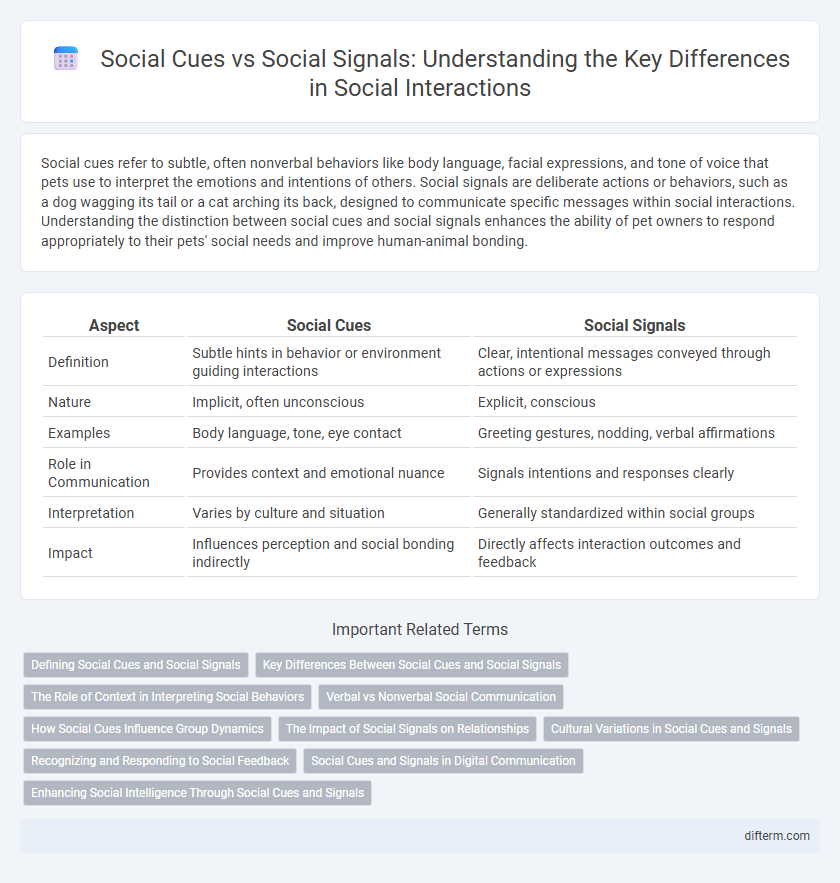Social cues refer to subtle, often nonverbal behaviors like body language, facial expressions, and tone of voice that pets use to interpret the emotions and intentions of others. Social signals are deliberate actions or behaviors, such as a dog wagging its tail or a cat arching its back, designed to communicate specific messages within social interactions. Understanding the distinction between social cues and social signals enhances the ability of pet owners to respond appropriately to their pets' social needs and improve human-animal bonding.
Table of Comparison
| Aspect | Social Cues | Social Signals |
|---|---|---|
| Definition | Subtle hints in behavior or environment guiding interactions | Clear, intentional messages conveyed through actions or expressions |
| Nature | Implicit, often unconscious | Explicit, conscious |
| Examples | Body language, tone, eye contact | Greeting gestures, nodding, verbal affirmations |
| Role in Communication | Provides context and emotional nuance | Signals intentions and responses clearly |
| Interpretation | Varies by culture and situation | Generally standardized within social groups |
| Impact | Influences perception and social bonding indirectly | Directly affects interaction outcomes and feedback |
Defining Social Cues and Social Signals
Social cues are subtle, non-verbal indicators like body language, facial expressions, and tone of voice that convey emotions and intentions in social interactions. Social signals, on the other hand, are intentional actions or behaviors designed to communicate specific messages to others, such as hand gestures or eye contact. Understanding the distinction between social cues and social signals is essential for effective interpersonal communication and social cognition.
Key Differences Between Social Cues and Social Signals
Social cues are nonverbal or verbal indicators such as facial expressions, tone of voice, and body language that individuals use to interpret others' emotions and intentions within social interactions. Social signals, in contrast, are more deliberate and conscious communications, including gestures or specific expressions designed to convey clear messages and influence social behavior. Understanding the key differences between these concepts is crucial for effective communication, emotional intelligence, and social dynamics in both personal and professional settings.
The Role of Context in Interpreting Social Behaviors
Social cues such as facial expressions, tone of voice, and body language provide raw data that individuals use to navigate interactions, but their meaning often depends heavily on context including cultural norms, relationship dynamics, and situational factors. Social signals emerge when these cues are interpreted within a specific environment, enabling accurate communication of emotions, intentions, or social status. Misinterpretation of social signals can occur if contextual elements like setting, past interactions, or group culture are overlooked, highlighting the critical role of context in decoding social behaviors effectively.
Verbal vs Nonverbal Social Communication
Verbal social communication relies on spoken language, tone, and word choice to convey meaning, making it explicit and easily interpretable. Nonverbal social communication includes body language, facial expressions, gestures, and eye contact, providing implicit context that complements or contradicts verbal messages. Understanding the interplay between verbal social cues and nonverbal social signals is essential for effective interaction and accurate interpretation of intent in social contexts.
How Social Cues Influence Group Dynamics
Social cues, such as facial expressions, tone of voice, and body language, play a crucial role in shaping group dynamics by providing contextual information that guides individual behavior and decision-making. These nonverbal signals help establish norms, regulate conversations, and synchronize group actions, enhancing cooperation and reducing misunderstandings. Understanding the impact of social cues enables better prediction of group cohesion and conflict resolution in social settings.
The Impact of Social Signals on Relationships
Social signals, such as facial expressions, tone of voice, and body language, play a crucial role in shaping interpersonal relationships by conveying emotions and intentions more effectively than verbal communication alone. These nonverbal cues influence trust, empathy, and social bonding, directly affecting the quality and longevity of personal and professional connections. Understanding and accurately interpreting social signals can lead to improved communication outcomes and stronger, more meaningful relationships.
Cultural Variations in Social Cues and Signals
Cultural variations significantly influence the interpretation of social cues and social signals, as gestures, facial expressions, and body language can differ widely across societies. For example, eye contact may signify confidence in Western cultures but be seen as disrespectful in some Asian cultures, altering the perceived social signal. Understanding these nuanced cultural differences is crucial for effective cross-cultural communication and avoiding misunderstandings.
Recognizing and Responding to Social Feedback
Recognizing social cues such as facial expressions, tone of voice, and body language enables individuals to interpret subtle messages within interactions, facilitating effective communication. Social signals, including gestures and posture, serve as explicit feedback that guide appropriate responses and adapt behavior in real-time social exchanges. Developing sensitivity to these social feedback mechanisms enhances interpersonal relationships and emotional intelligence by promoting empathy and mutual understanding.
Social Cues and Signals in Digital Communication
Social cues in digital communication include nonverbal elements like tone, emoji usage, and response timing, which help convey emotions and intent beyond text. Social signals are interpreted clues from these cues that influence how messages are perceived and guide social interactions online. Understanding the nuances of social cues and signals enhances clarity and reduces misunderstandings in virtual environments.
Enhancing Social Intelligence Through Social Cues and Signals
Social cues, such as body language, facial expressions, and tone of voice, provide vital information that helps interpret others' emotions and intentions, enhancing social intelligence. Social signals are deliberate actions or communication patterns used to convey specific messages and influence social interactions effectively. Mastering the interpretation and use of both social cues and signals improves empathy, decision-making, and relationship-building skills in complex social environments.
social cues vs social signals Infographic

 difterm.com
difterm.com